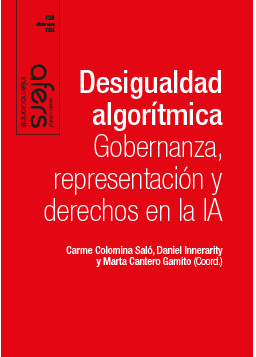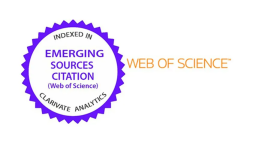Acceso a la justicia en tiempos de IA: ¿hacia una justicia low-cost?
Palabras clave:
inteligencia artificial (IA), justicia, algoritmos, low-cost, discriminación, vulnerabilidad, acceso a la justiciaResumen
Revista CIDOB d’Afers Internacionals, nº 138, pp 51-71
Cuatrimestral (octubre-diciembre 2024)
ISSN:1133-6595 | E-ISSN:2013-035X
DOI: https://doi.org/10.24241/rcai.2024.138.3.51
Los debates actuales sobre la introducción de la inteligencia artificial (IA) en la administración de justicia, que se reflejan también en la formulación de políticas, se han centrado principalmente en la salvaguarda de la imparcialidad, la transparencia, la explicabilidad, y la supervisión humana en la toma de decisiones, incluyendo las decisiones judiciales. Sin embargo, en paralelo a la cuestión de si la IA puede resolver las crisis de eficiencia del poder judicial, resulta necesario reflexionar sobre la próxima transformación del poder judicial desde la perspectiva del acceso a la justicia. Este artículo problematiza el uso de la IA en los tribunales y defiende la necesidad de evaluar el impacto de la IA en este ámbito desde la perspectiva del acceso a la justicia, en el contexto de la crisis de (acceso a) la justicia en una economía centrada en la inmediatez y el modelo de consumo low-cost.
Citas
Araujo, Theo; Helberger, Natali; Kruikemeier, Sanne y de Vreese, Claes H. «In AI We Trust? Perceptions about Automated Decision-Making by Artificial Intelligence». AI & Society, vol. 35, n.º 3 (2020), p. 611-623. DOI: https://doi.org/10.1007/s00146-019-00931-w
Barona Vilar, Silvia. Algoritmización del derecho y de la justicia: De la inteligencia artificial a la Smart Justice. Valencia: Tirant lo Blanch, 2021.
Bradford, Ben, Jackson, Jonathan y Hough, Mike. «Trust in Justice», en: Uslaner, Eric (ed.) The Oxford Handbook of Social and Political Trust. Oxford University Press, 2016, p. 633-654.
Burrell, Jenna. «How the Machine ‘Thinks’: Understanding Opacity in Machine Learning Algorithms». Big Data & Society, vol. 3, n.º 1 (2016) (en línea) https://doi.org/10.1177/2053951715622512
Cappelletti, Mauro. «Alternative Dispute Resolution Processes within the Framework of the World-Wide Access-to-Justice Movement». The Modern Law Review, vol. 56, n.º 3 (1993), p. 282-296. DOI: https://doi.org/10.1111/j.1468-2230.1993.tb02673.x
Carvajal, Diana María Ramírez. Justicia Digital: una mirada internacional en época de crisis. Universidad de Salamanca, 2020.
Casarosa, Federica. «Online Auction Sites: An Example of Regulation in Electronic Communities?». European Review of Private Law, vol. 17, n.º 1 (2009), p. 1-23. DOI: https://doi.org/10.54648/erpl2009001
Casarosa, Federica. «Out-of-Court Dispute Settlement Mechanisms for Failures in Content Moderation Monograph on the Administration of Justice in a Digital Era». Journal of Intellectual Property, Information Technology and Electronic Commerce Law, vol. 14, n.º 3 (2023), p. 391-402.
Castelliano, Caio, y Aquino Guimaraes, Tomas. «Court Disposition Time in Brazil and in European Countries». Revista Direito GV, vol. 19, (2023), p. 1-24. DOI: https://doi.org/10.1590/2317-6172202302
Castelvecchi, Davide. «Can We Open the Black Box of AI?» Nature News, vol. 538, n.º 7623 (5 de octubre de 2016) (en línea) https://www.nature.com/news/can-we-open-the-black-box-of-ai-1.20731
CEPEJ-European Commission for the Efficiency of Justice. «Special File - Report "European Judicial Systems - CEPEJ Evaluation Report - 2022 Evaluation Cycle (2020 Data)», (5 de octubre de 2022) (en línea) https://www.coe.int/en/web/cepej/special-file-report-european-judicial-systems-cepej-evaluation-report-2022-evaluation-cycle-2020-data-
Coglianese, Cary y Ben-Dor, Lavi M. «AI in Adjudication and Administration». Brooklyn Law Review, vol. 86, n.º 3 (2021), p. 791-838.
Comisión Europea. «Consumer Scoreboard», (27 de marzo de 2023) (en línea) https://ec.europa.eu/commission/presscorner/detail/en/ip_23_1891
Edwards, Lilian, y Michael Veale. «Enslaving the Algorithm: From a “Right to an Explanation” to a “Right to Better Decisions”?» IEEE Security & Privacy, vol. 16, n.º 3 (2018), p. 46-54. DOI: https://doi.org/10.1109/MSP.2018.2701152
Galanter, Marc. «Access to Justice in a World of Expanding Social Capability». Fordham Urban Law Journal, vol. 37, n.º 1 (2010), p. 115-128.
Garth, Bryant G. y Cappelletti, Mauro. «Access to Justice: The Newest Wave in the Worldwide Movement to Make Rights Effective». Buffalo Law Review, vol. 27, (1978), p. 181-292.
Gentile, Giulia. «AI in the Courtroom and Judicial Independence: An EU Perspective». EUIdeas, (22 de agosto de 2022) (en línea) https://euideas.eui.eu/2022/08/22/ai-in-the-courtroom-and-judicial-independence-an-eu-perspective/
Gentile, Giulia. «Artificial Intelligence and the Crises of Judicial Power: (Not) Cutting the Gordian Knot?», en: De Gregorio, Giovanni; Pollicino, Oreste y Valcke, Peggy (eds.) Oxford Handbook of Digital Constitutionalism. Oxford: Oxford University Press, 2024 (en prensa) (en línea) https://ssrn.com/abstract=4731231
Glover, J. Maria. «Disappearing Claims and the Erosion of Substantive Law». Yale Law Journal, vol. 124, n.º 8 (2014), p. 3.052-3.093.
Innerarity, Daniel. «Predicting the past: a philosophical critique of predictive analytics». IDP. Revista de Internet, Derecho y Política, n.º 39 (2023), p. 1-12. DOI: https://doi.org/10.7238/idp.v0i39.409672
Katsh, Ethan. «Online dispute resolution: Some lessons from the e-commerce revolution». Northern Kentucky Law Review, vol 28, n.º 4 (2001), p. 810-821.
Katsh, Ethan y Rule, Colin. «What We Know and Need to Know about Online Dispute Resolution White Papers». South Carolina Law Review, vol. 67, n.º 2 (2015), p. 329-344.
Kleinberg, Jon; Ludwig, Jens; Mullainathan, Sendhil y Sunstein, Cass R. «Discrimination in the Age of Algorithms». Journal of Legal Analysis, vol. 10 (2018), p. 113-174. DOI: https://doi.org/10.1093/jla/laz001
Klonick, Kate. «The New Governors: The People, Rules, and Processes Governing Online Speech». Harvard Law Review, vol. 131, n.º 6 (2018), p. 1.599-1.670.
Koivisto, Ida. The Transparency Paradox. Oxford y Nueva York: Oxford University Press, 2022.
Kontiainen, Laura; Koulu, Riikka y Sankari, Suvi. «Research Agenda for Algorithmic Fairness Studies: Access to Justice Lessons for Interdisciplinary Research». Frontiers in Artificial Intelligence, vol. 5, (2022), p. 1-13. DOI: https://doi.org/10.3389/frai.2022.882134
Lorenzo Pérez, Cristina. «Inteligencia artificial en la Administración de Justicia: Regulación española y marco europeo e internacional. Proyectos desarrollados por el Ministerio de Justicia de España». Centro de Estudios Jurídicos, (marzo de 2022) (en línea) https://www.cej-mjusticia.es/sede/publicaciones/ver/13637
Delgado Martín, Joaquín. «Justicia, juicios telemáticos y ecnología para afrontar los efectos de la pandemia sobre la justicia». Asuntos Constucionales, vol. 1 (2021), p. 75-94.
Mora-Sanguinetti, Juan S. La factura de la injusticia. Madrid: Tecnos, 2022.
OCDE-Organización para la Cooperación y el Desarrollo Económico. «Government at a Glance 2021». OECD, (9 de julio de 2021) (en línea) https://doi.org/10.1787/1c258f55-en
Palmiotto, Francesca. «The Black Box on Trial: The Impact of Algorithmic Opacity on Fair Trial Rights in Criminal Proceedings», en: Ebers, Martin y Cantero Gamito, Marta (eds.) Algorithmic Governance and Governance of Algorithms: Legal and Ethical Challenges. Cham: Springer, 2021, p. 49-70.
Pilving, Ivo. «Guidance-Based Algorithms for Automated Decision-Making in Public Administration: The Estonian Perspective». CERIDAP, (20 de febrero de 2023) (en línea) https://doi.org/10.13130/2723-9195/2023-1-105
Re, Richard M. y Solow-Niederman, Alicia. «Developing Artificially Intelligent Justice». Stanford Technology Law Review, vol. 22, n.º 2 (2019) (en línea) https://law.stanford.edu/publications/developing-artificially-intelligent-justice-stanford-technology-law-review/
Susskind, Richard. Online Courts and the Future of Justice. Oxford y Nueva York: Oxford University Press, 2021.
Wachter, Sandra; Mittelstadt, Brent y Russell, Chris. «Why fairness cannot be automated: Bridging the gap between EU non-discrimination law and AI». Computer Law & Security Review, vol. 41 (2021) (en línea) https://doi.org/10.1016/j.clsr.2021.105567
Willett, Chris y Morgan-Taylor, Martin. «Recognising the limits of transparency in EU consumer law», en: Devenney, James y Kenny, Mel (eds.) European Consumer Protection: Theory and Practice. Cambridge: Cambridge University Press, 2012, p. 143-163.
WJP-World Justice Project. «WJP Rule of Law Index», (2023) (en línea) [Fecha de consulta: 30.06.2024] https://worldjusticeproject.org/rule-of-law-index
Xenidis, Raphaële, y Senden, Linda. «EU non-discrimination law in the era of artificial intelligence: Mapping the challenges of algorithmic discrimination», en: Bernitz, Ulf; Groussot, Xavier; Paju, Jaan y De Vries, Sybe A. (eds.) General principles of EU law and the EU digital order. Alphen aan den Rijn: Kluwer Law International, 2020, p. 151-182.
Zalnieriute, Monika. «“Transparency Washing” in the Digital Age: A Corporate Agenda of Procedural Fetishism Special Issue: Transparency in the Digital Environment». Critical Analysis of Law: An International & Interdisciplinary Law Review, vol. 8, n.º 1 (2021), p. 139-153.
Zalnieriute, Monika; Moses, Lyria B. y Williams, George. «The Rule of Law and Automation of Government Decision-Making». The Modern Law Review, vol. 82, n.º 3 (2019), p. 425-455. DOI: https://doi.org/10.1111/1468-2230.12412












